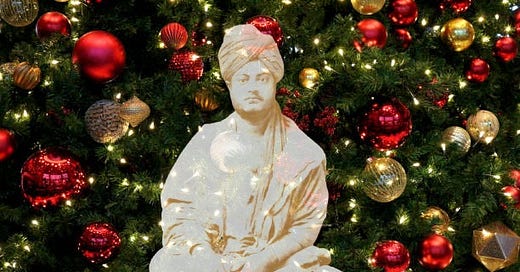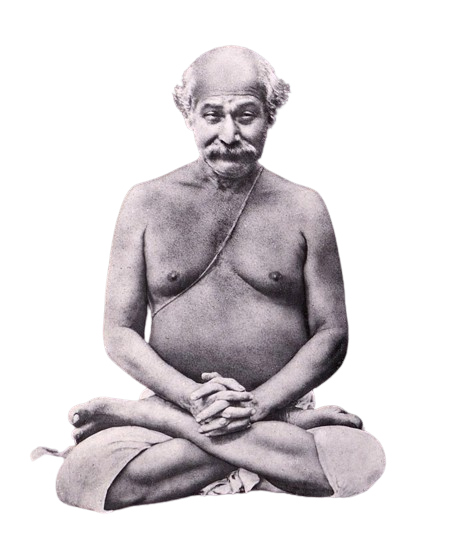Yogananda and the Christmas Vision of a Silver Cup (Historical Near-Death Experiences of the Month)
Two 19th Century NDEs Surrounding the Famous Guru
As regular readers know, accounts of near-death experiences crop up in unexpected places — historical documents, ethnographic reports, and religious literature to name a few. Given its status as spiritual classic, it’s perhaps not surprising that two examples can be found in Paramahansa Yogananda’s Autobiography of a Yogi, nestled among the abundance of accounts of extraordinary experiences of all description that make up such an integral part of the book.
Surprisingly, however, the two examples found in the book seem to be unknown in near-death studies. This is perhaps because they’re atypical when viewed from the standpoint of popular Western notions about NDE. It’s also the case that their main function was not to give evidence of, or information about, the afterlife. Instead, they are but two more examples of the countless miracles that serve to glorify Indian holy figures more generally — including Swami Vivekananda and Lahiri Mahasaya.
Both accounts date to sometime in the late 19th century, and involve the NDEr encountering a guru during the experience. The first was brought to Yogananda’s attention when he gave a Christmas gift to one of his American disciples, Mr. E.E. Dickinson. The gift was a silver cup which he had purchased on a trip to India. Dickinson told his story to Yogananda at the Self-Realization Fellowship’s annual Christmas party, as the guru handed out gifts to the devotees. As Yoganda wrote:
“Mr. Dickinson!” The next parcel contained a gift which I had bought in a Calcutta bazaar. “Mr. Dickinson will like this,” I had thought at the time. A dearly beloved disciple, Mr. Dickinson had been present at every Christmas festivity since the 1925 founding of Mt. Washington [the Self-Realization Fellowship headquarters in Los Angeles]. At this eleventh annual celebration, he was standing before me, untying the ribbons of his square little package.
“The silver cup!” Struggling with emotion, he stared at the present, a tall drinking cup. He seated himself some distance away, apparently in a daze. I smiled at him affectionately before resuming my role as Santa Claus.
The ejaculatory evening closed with a prayer to the Giver of all gifts; then a group singing of Christmas carols.
Mr. Dickinson and I were chatting together sometime later.
“Sir,” he said, “please let me thank you now for the silver cup. I could not find any words on Christmas night.”
“I brought the gift especially for you.”
“For forty-three years I have been waiting for that silver cup! It is a long story, one I have kept hidden within me.” Mr. Dickinson looked at me shyly. “The beginning was dramatic: I was drowning. My older brother had playfully pushed me into a fifteen foot pool in a small town in Nebraska. I was only five years old then. As I was about to sink for the second time under the water, a dazzling multicolored light appeared, filling all space. In the midst was the figure of a man with tranquil eyes and a reassuring smile. My body was sinking for the third time when one of my brother’s companions bent a tall slender willow tree in such a low dip that I could grasp it with my desperate fingers. The boys lifted me to the bank and successfully gave me first-aid treatment.
“Twelve years later, a youth of seventeen, I visited Chicago with my mother. It was September 1893; the great World Parliament of Religions was in session. Mother and I were walking down a main street, when again I saw the mighty flash of light. A few paces away, strolling leisurely along, was the same man I had seen years before in vision. He approached a large auditorium and vanished within the door.
“‘Mother,’ I cried, ‘that was the man who appeared at the time I was drowning!’
“She and I hastened into the building; the man was seated on a lecture platform. We soon learned that he was Swami Vivekananda of India. After he had given a soul-stirring talk, I went forward to meet him. He smiled on me graciously, as though we were old friends. I was so young that I did not know how to give expression to my feelings, but in my heart I was hoping that he would offer to be my teacher. He read my thought.
“‘No, my son, I am not your guru.’ Vivekananda gazed with his beautiful, piercing eyes deep into my own. ‘Your teacher will come later. He will give you a silver cup.’ After a little pause, he added, smiling. ‘He will pour out to you more blessings than you are now able to hold.’
“I left Chicago in a few days,” Mr. Dickinson went on, “and never saw the great: Vivekananda again. But every word he had uttered was indelibly written on my inmost consciousness. Years passed; no teacher appeared. One night in 1925 I prayed deeply that the Lord would send me my guru. A few hours later, I was awakened from sleep by soft strains of melody. A band of celestial beings, carrying flutes and other instruments, came before my view. After filling the air with glorious music, the angels slowly vanished.
“The next evening I attended, for the first time, one of your lectures here in Los Angeles, and knew then that my prayer had been granted.”
We smiled at cach other in silence.
“For eleven years now I have been your Kriya Yoga disciple,” Mr. Dickinson continued. “Sometimes I wondered about the silver cup; I had almost persuaded myself that the words of Vivekananda were only metaphorical.
“But on Christmas night, as you handed me the little box by the tree, I saw, for the third time in my life, the same dazzling flash of light. In another minute I was gazing on my guru’s gift that Vivekananda had foreseen for me forty-three years earlier – a silver cup!”
“I saw Lahiri Mahasaya in a blaze of light!”
In a second brief NDE related by Yogananda, the guru Lahiri Mahasaya brought a man named Rama back to life. Rama was a friend of Sri Yukteswar Giri, who was a disciple of Lahiri’s (and Yogananda’s own guru). When Rama was dying from cholera, Yukteswar went to Lahiri for help, but the guru gave only encouragement, telling Yukteswar to have faith in the doctors and that “Rama will be well.” Rama died, however, and Yukteswar again went to Lahiriri. The guru had him sit and meditate with him until the following morning. As Yogananda recounted, quoting Yukteswar:
“At dawn Lahiri Mahasaya glanced at me consolingly. ‘I see you are still disturbed. Why didn’t you explain yesterday that you expected me to give Rama tangible aid in the form of some medicine?’ The master pointed to a cup-shaped lamp containing crude castor oil. ‘Fill a little bottle with oil from the lamp; put seven drops in Rama’s mouth.’
“‘Sir? I remonstrated, ‘he has been dead since yesterday noon. Of what use is the oil now?’
“‘Never mind, just do as I ask.’ My guru’s cheerful mood was incomprehensible to me; I was still in an unassuaged agony of bereavement. Pouring out a small amount of oil, I departed for Rama’s house.
“I found my friend’s body rigid in the death-clasp. Paying no attention to his ghastly condition, I opened his lips with my right index finger; and managed, with my left hand and the help of the cork, to put the oil drop by drop over his clenched teeth. As the seventh drop touched his cold lips, Rama shivered violently. His muscles from head to foot vibrated as he sat up wonderingly.
“I saw Lahiri Mahasaya in a blaze of light!” he cried. “He shone like the sun. ‘Arise, forsake your sleep,’ he commanded me. “Come with Yukteswar to see me.’”
“I could scarcely believe my eyes when Rama dressed himself and was strong enough after that fatal sickness to walk to the home of our guru. There he prostrated himself before Lahiri Mahasaya with tears of gratitude.
“The master was beside himself with mirth. His eyes twinkled at me mischievously.”
Further details of Rama’s experience are unfortunately lacking. The deliberate appearance of Lahiri as a being of light begs the question of what, if anything, Rama might have experienced prior to the guru’s intervention. It transpires in the account that Lahiri actually allowed Rama to die in order to teach Yukteswar a lesson about having faith in his guru and in the Supreme Soul (Paramatman).
This Substack is free, though I’m allowing paid subscriptions for those who wish to support my work. Alternatively, become a patron on Patreon. All subscribers and patrons at any tier will receive one or more of my books and various other benefits.









